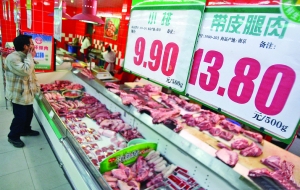 Beijing CPI rose at a low of 6, 7, and 8 months before returning to the 3% level. On the 17th, the Beijing Municipal Bureau of Statistics and the National Bureau of Statistics released the Beijing Survey Group. The total consumer price index (CPI) of Beijing residents in September rose by 3% year-on-year. The price of pork eggs fluctuates steadily, and its impact on the overall level of consumer prices has declined. Market analysts analyzed that the boost to consumer demand caused by the Mid-Autumn National Day holiday is an important reason for the CPI increase. It is expected that it will also rebound moderately due to climate change and the approaching Spring Festival.
Beijing CPI rose at a low of 6, 7, and 8 months before returning to the 3% level. On the 17th, the Beijing Municipal Bureau of Statistics and the National Bureau of Statistics released the Beijing Survey Group. The total consumer price index (CPI) of Beijing residents in September rose by 3% year-on-year. The price of pork eggs fluctuates steadily, and its impact on the overall level of consumer prices has declined. Market analysts analyzed that the boost to consumer demand caused by the Mid-Autumn National Day holiday is an important reason for the CPI increase. It is expected that it will also rebound moderately due to climate change and the approaching Spring Festival. In September, the city’s food prices rose 4.7%, non-food prices rose 2.5%, consumer goods prices rose 2%, and service items prices rose 4.8%. From January to September, the total level of consumer prices in Beijing increased by 3.3% over the same period of last year. Although the increase was relatively modest, food prices remained the most important factor affecting the September CPI, driving the CPI to rise by about 1.25 percentage points year-on-year. Among them, the price of fresh fruit rose by 16.7%, affecting the overall level of consumer price increase by about 0.26 percentage points; the price of fresh vegetables rose by 7.5%, affecting the overall level of consumer price increase by about 0.11 percentage points; the price of pork falling by 16.4%, affecting the total consumer price. The level dropped by about 0.32 percentage points; egg prices fell by 1.3%, affecting the overall level of consumer prices by about 0.01 percentage points.
Among non-food commodities, the highest year-on-year increase in September was the price of entertainment and educational goods and services, up 4.7% year-on-year. Among them, the prices of durable consumer goods and services for entertainment and entertainment decreased by 8.1%, and tourism prices increased by 5.6%, which indicates the pulling of the “11th†holiday.
It is worth noting that the year-end carryover factor gradually faded and the new price increase factor has become the main force pushing up the CPI. According to calculations, in the 3% consumer price increase in September, the hikes in the price increase last year were about 0.1 percentage point, and the new price increase factor was about 2.9 percentage points this year.
Looking from the ring, in September, food prices rose 0.3%, affecting the overall level of consumer prices rose by about 0.07 percentage points. Among them, the price of fresh fruit rose by 6.8%, affecting the overall level of consumer price increase by about 0.11 percentage point; the price of pork rose by 2.1%, affecting the overall level of consumer price increase by about 0.03%; the price of egg rose by 4%, affecting the overall level of consumer price It rose by about 0.02%.
Through September, the price of meat and eggs that had undergone price fluctuations was relatively stable. The reporter learned from the new wholesale market that the price of pork rose slowly in September, while egg prices have steadily declined. Market monitoring data showed that the average price of white striped pigs was 9.05 yuan/kg on September 1. The price was 9.25 yuan/kg on the 30th. The price at the end of the month was 2.21% higher than the price at the beginning of the month, indicating that the price in September was slow. Rising, not much gain. The price at the end of September last year was RMB 11.50/kg, a decrease of 19.87% year-on-year.
“The consumption power of pork is recovering and it has basically got rid of the state of weak consumption.†Liu Tong, head of the statistics department of Xinfa Land, analyzed that the government’s measures to collect and support the city have been effective, and the rising cost of farming has also stimulated pork prices. rise. In addition, the price of eggs in early September was 4.72 yuan/kg, and the price at the end of the month was 4.38 yuan/kg, and it was 7.2% lower than the beginning of the month at the end of the month.
Substitute tea refers to the use of edible plant leaves, flowers, fruits (fruit), roots, etc., using the way of drinking tea (by brewing, boiling, etc.) is a kind of products commonly known.
Substitute tea is divided into leaf, flower, fruit and rhizome; The way of drinking the same as tea is generally composed of one or more items in the two categories of "medicine and food homology" and "can be used for health care" in the food classification stipulated by the Ministry of Health. Tea products made from the roots, stems, leaves or fruits of these plants.
The way of drinking the same as tea, generally by the ministry of Health provisions of food classification of medicine and food homologous category, can be used for health care category, two types of goods in the single or multiple items, with the roots, stems, leaves or fruits of these plants made of tea products.
Substitute tea has certain effect and auxiliary effect for some special groups, belonging to the health conditioning products.
Alternative Tea,Hot Drink Alternative To Tea,Tea Substitute,Green Tea Alternative
XuChang Youjia Food Product Development Co., LTD , https://www.yjgrain.com